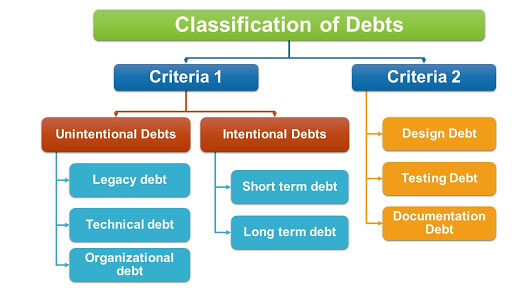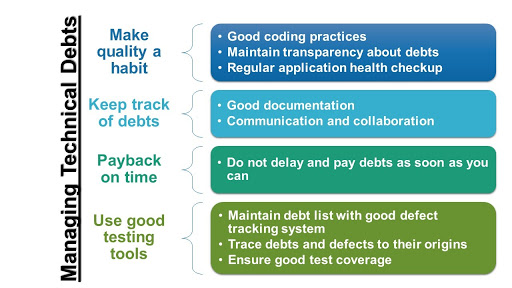Accelerate Success with AI-Powered Test Automation – Smarter, Faster, Flawless
Start free trialWhat is Technical Debt?
The term technical debt was coined by Ward Cunningham to describe how long-term quality is sometimes compromised for short-term gains, like increased development velocity, often due to constraints related to resources or schedule. In simpler words, technical debt is the difference between the expectations and what was delivered. In many instances, technical debts are knowingly incurred to fulfill high-priority business objectives. In any case, technical debts can get accrued with time, and if not paid back, can lead to inhibiting future development process, while increasing overall costs.
Types of Technical Debt
Technical debts can be classified based on 2 different criteria.

| Criteria 1 | |
| Intentional Debt | Unintentional Debt |
| In agile software development, time to market a feature is critical. To achieve that, organizations make an informed decision to compromise as a part of development strategy. Sometimes, resource crunch also becomes a factor in incurring intentional debt. These are known debts that are added to the product backlog to be paid back later in future releases Intentional debts are of 2 types: Short-term: It is a reactive debt that is incurred for tactical reasons, like meeting deadlines. Long-term: It is a proactive debt that is incurred for strategic reasons, like postponing a feature/upgrade. |
Unintentional or accidental debt is incurred inadvertently due to multiple reasons, the most common being lack of adherence to technical and quality standards. Unintentional debt can be further classified into Legacy: Using outdated code and libraries as a part of application legacy Technical: Lack of skills and not adhering to coding standards Organizational: Absence of good process and strategy, lack of work ethics, bad management |
| Criteria 2 | |
| Design Debt | Design debt is a consequence of inadequately designed components either due to lack of knowledge or due to non-adherence to industry standards. It is also a result of failure to evolve as per the changing needs and update the design as per new inputs. |
| Testing Debt | Testing debt is a consequence of not executing the planned tests due to multiple reasons, the most common being,
|
| Documentation Debt | Documentation debts are a result of insufficient, incorrect, or outdated documentation. |
What Makes Mounting Technical Debt a Scary Prospect?
Like monetary debts, technical debts also accrue interest with time. They need to be addressed and paid back within a stipulated time to avoid technical bankruptcy. The consequences of accrued debts can put an organization’s reputation in the market at stake.
| Consequences of technical debt | |
| Overshooting the planned estimates |
|
| Quality issues |
|
| Dissatisfied customer |
|
| Worst case scenario |
|
Overshooting the planned estimates
The planning and estimates can go haywire if debts are not addressed well in time. The development team may end up spending more time paying the debts by handling the product backlogs. This could lead to cost overruns due to missed deadlines, over usage of resources in addressing legacy debts.
Quality Issues
- SecurityTechnical debts that incur due to design flaws or shortcuts can cause security loopholes that may prove costly to the product’s overall health.
- Performance: The performance of the system as a whole may take a hit as there might be a redundant section of legacy code, which gets executed every single time, even though it is not needed. There could be outdated libraries being referred to, or old standards being used.
- Scalability: Mounting debt may impact the ability to add a new feature without affecting the current one.
- Maintainability: Sometimes, to meet the deadline compromises are made, like finding workarounds instead of addressing the real problems. This adds to unnecessary code snippets which may not contribute later and may end up as dead code, adding to debts in the long run.
- Inadequate functionalities: Some low-priority features may not make it to the final cut in a sprint due to time constraints. Fixes to one feature may impact another, if not done properly, leading to malfunctioning.
Dissatisfied customers
Customers may be dissatisfied due to quality issues and the inability to meet deadlines due to accrued debts.
Worst case scenario
As the complexity of software grows with time, if debts keep on adding up without any paybacks, then it leads to software entropy or in the worst case, failure of the system.

Managing Technical Debt
As stated in the earlier section, technical debts have to be paid back in time to maintain the overall health of the software.
Strategic and technical teams need to keep a check on the debts incurred during the development process by keeping track of debt indicators like,
- Number of defects that have been deferred for the next release
- Number of approved, yet unfulfilled, requirements
- Number of test cases that need updating as per the changes
- Number of test cases that need to be automated and added to the regression suite
- Documentation that needs to be updated as per the changes and new features
These debt indicators aid in quantifying the cost, time, and efforts involved in payback. Managing and preventing technical debts is a sign of a robust quality process of an organization.

Make Quality a Habit Across The Organization
- Follow good design coding practices and maintain code hygiene as part of the process and not as an obligation.
- Code refactoring should be done on an ongoing basis for legacy code.
- Be transparent about debts and maintain a product backlog. Treat each debt in the backlog as a scrum story and attach estimates for efforts and time with it to keep the schedule on track. d. Conduct regular health checkups of the application.
Keep Track of Items Incurring Debt
- Good documentation is the key to tracking debts. Do not treat documentation as an overhead and leave it for later. Keep updating documents in parallel.
- Communicate debt details to all the stakeholders, business and technical. It makes it easier to collaborate and work on them to chalk out future development strategies.
Payback on Time
Technical debts are similar to monetary debts, the principal being current tasks and interest being the backlog. The longer debt repayment is delayed, the more difficult and expensive it gets with accrued interests. Hence, it is prudent just to have a quality sprint to clear the residual debts, either partially or in full depending on the schedules.
Use Good Tools for Testing
- Maintain a debt list with a good defect tracking system by reporting and prioritizing the defect. Attach a timeline of resolution for every debt. Any debt overshooting the defined timeline should be treated as critical.
- Maintain a debt list by tracing the defects to their origin i.e. user stories. It aids in identifying the causes for incurring the debt and appropriate action can be taken.
- Good test coverage helps in minimizing the debts by covering maximum possibilities for testing functionality.
- Increasing test automation, with less dependency on manual testing, leaves less scope for incurring testing debts.
- Clean up the test cases after every sprint. Outdated test cases should be removed to have a sanitized test plan.
How Webomates can Help You in Managing Technical Debts
Technical debts are a reality and are very much part of the whole development process. However, how those debts are managed is the key to product quality and successful releases.
Webomates can help organizations in managing their testing debts and reduce the overall burden.
Once a defect is found, our Test Package Analyzer identifies all the impacted test cases, traces them to impacted user stories/epics/requirements. Thus, giving you the exact origin of the defect encountered. The defects can be either managed within the same cycle or added to the product backlog depending on its priorities.
Our triaging process helps in attaching the priorities to the defects thus further adding value to your debt management process. Webomates CQ provides a comprehensive report with properly triaged defects. The QA and development team can access these reports, thereby allowing them to intervene on time and take appropriate action.
Webomates’ Intelligent Analytics improvises your testing process by providing a feedback loop of defects to requirements. It also keeps an eye on the results of exploratory testing and intelligently handles the results. If a module gets a high number of defects during exploratory testing, then it needs to be re-examined and more test cases need to be generated for the same.
Webomates applies AI and ML algorithms to its self-healing test automation framework to dynamically adapt the testing scope due to any changes. Healed test suites lead to faster testing and development, thus speeding up the entire release process. This increases the feature velocity and also reduces the debt burden since the issues are addressed early in the development cycle.
If this has piqued your interest and you want to know more, then please click here and schedule a demo, or reach out to us at info@webomates.com. If you liked this blog, then please like/follow us Webomates or Aseem.
Tags: Agile Testing, Automation, Software Testing, Technical debt

Leave a Reply